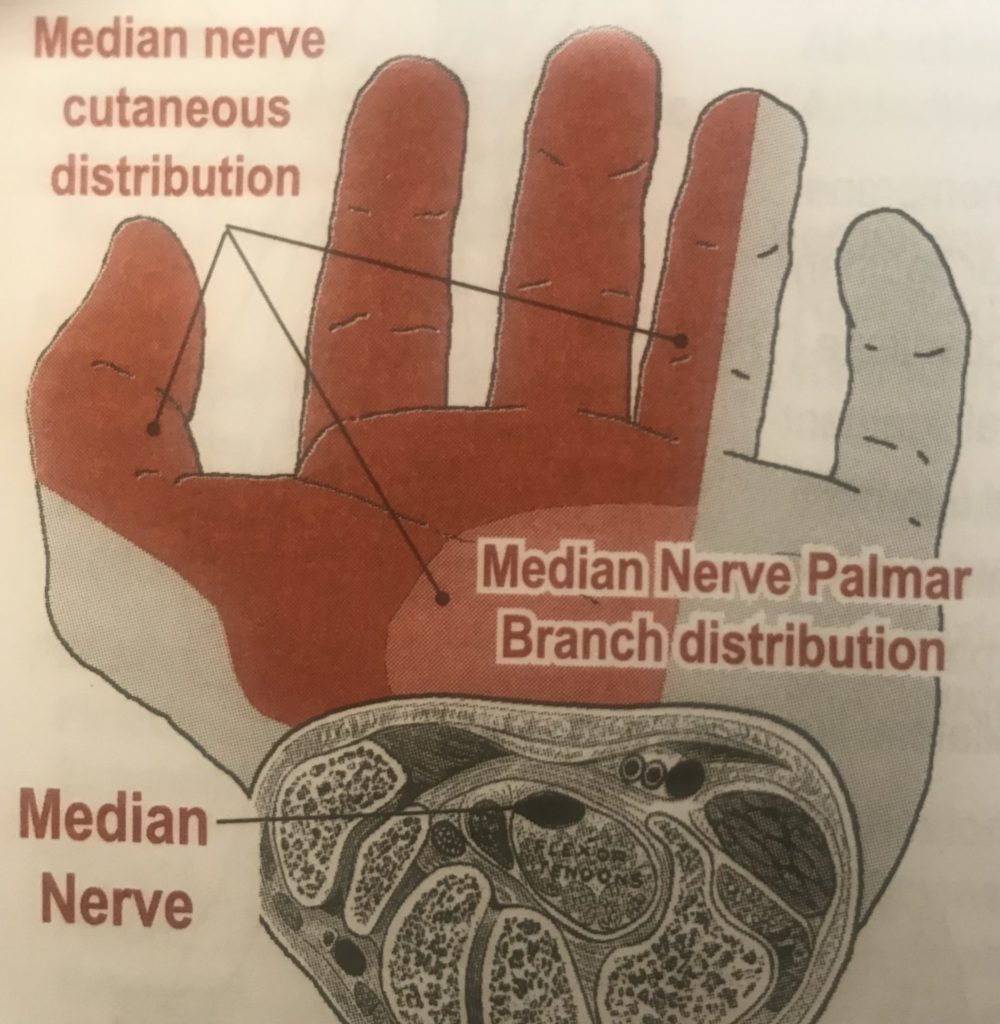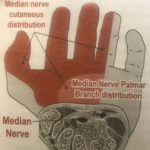
Carpal tunnel syndrome (CTS) is the most common peripheral nerve entrapment in the body, with as many as 3 in 10 women affected at some point during their lifetime.
Its debilitating nature is due to the many associated symptoms, ranging from persistent tingling or numbness, to pain and even weakness in the hand and fingers.
What causes carpal tunnel syndrome?
The symptoms of CTS are due to compression of the median nerve, which provides sensation and motor control to the hand. Classically, the compression occurs at the carpal tunnel, a narrow space through which the median nerve travels before it enters the palm of the hand.
Narrowing of the carpal tunnel and subsequent compression of the median nerve can have several causes:
- repetitive use of the wrist and finger flexors, e.g. typing, vibrating tools, massage
- subluxation of the carpal bones of the hand
- obesity
- fluid build-up in the carpal tunnel, e.g. due pregnancy, type-2 diabetes, hypothyroidism
- rheumatoid arthritis
- previous trauma to the wrist, e.g. fracture, laceration or dislocation
Treating more than just the carpal tunnel
Even though one of the characteristic features of carpal tunnel syndrome is, as the name implies, compression around the carpal tunnel, problems higher up the arm often play a major role. It is, thus, crucial to examine the nervous tissue for compression higher up the arm and neck.
This is explained by a phenomenon called the ‘double crush syndrome’. This means that when a nerve is already compressed at one site, a compression at another site is more likely to cause symptoms.
In effect, the nerve acts like a hose pipe: the more kinks, the less water reaches the end.
An example of double crush syndrome is a cervical nerve root impingement – for instance due to a disc prolapse or neck osteoarthritis – predisposing to symptoms of CTS, even if there is only a mild narrowing of the carpal tunnel that would otherwise not bring on symptoms.
It is all about the nerve already being sensitised by the time it reaches the carpal tunnel. So, two (or more) low-grade compressions along a nerve can be worse than one large compression.
Clinically, double crush syndrome means that treatment directed merely at the carpal tunnel is unlikely to resolve the symptoms. This explains why surgery for carpal tunnel syndrome is often unsuccessful.
If you have had unsuccessful surgery for carpal tunnel syndrome, book an appointment with an osteopath who will look at the whole arm and the neck.
Double crush syndrome is very common and also shows up in thoracic outlet syndrome, sciatic neuropathy, radial neuropathy, ulnar neuropathy etc.
It is one of the reasons holistic therapies, such as osteopathy or acupuncture, are so much more effective than localised interventions, such as surgery or physiotherapy.
Who gets CTS?
Carpal tunnel syndrome is up to ten times more common in women than men. Some of the risk factors – rheumatoid arthritis, hypothyroidism and pregnancy – explain the higher incidence in women.
As is the case with thoracic outlet syndrome, it is especially crucial to exclude systemic causes if CTS presents on both sides of the body.
What are the symptoms?
- transient numbness and tingling over the thumb, index and middle finger. In most cases, the palm is spared because the palmar branch of the median nerve does not normally pass through the carpal tunnel.
- hand often ‘falls asleep’ (shaking the hand about usually helps)
- loss of grip strength and loss of fine motor control (e.g. dropping objects, struggling to button up a shirt)
- worsening of symptoms with typing, drawing, driving
- the pain may radiate into the forearm or elbow (there is often overlap with golfer’s elbow)
- the hand may feel unusually hot or cold
How is carpal tunnel syndrome diagnosed?
A good case history is very useful.
As an osteopath, I use palpation to get a feel of the muscles and joints of the arm and wrist. Osteopaths will also use orthopaedic tests to ascertain which movements reproduce the tingling.
Diagnostic imaging is only required if other pathologies need to be ruled out. MRI is the best option if the diagnosis is still unclear.
Nerve conduction studies and electromyography can determine the degree of nerve compression. However, they are rarely required.
What are the treatments for carpal tunnel syndrome?
Conventional techniques
If the injury is acute, you should avoid aggravating movements, and, where possible, rest the wrist and hand. Ice can help reduce any local inflammation which is likely to irritate the median nerve as it passes through the carpal tunnel. Later, you can use heat therapy.
If your symptoms are aggravated at work, you may benefit from an ergonomic workplace assessment. You can also use a wrist support.
Exercises
Exercise should focus on stretching the wrist flexors, the pectoralis minor muscle and the scalene muscles in the neck. The aim is to take as much pressure off the median nerve as possible. Any stretch should be held for 30 seconds.
Massage
A massage therapist will work with the forearm flexor muscles, the scalene muscles, and shoulder muscles. A massage therapist will also address trigger points.
Acupuncture
An acupuncturist will work with the local wrist points SP10, PC6 and 7, SJ5,6 and 10, and LI4,5 and 9. An acupuncturist will also work with the meridians/channels that run along the arm.
Surgery
Surgical intervention involves the cutting of the flexor retinaculum, a ligament that covers the tunnel. Surgery is rarely required and should only be considered in severe cases where conventional treatment has been unsuccessful.
As explained above, surgery often fails to resolve the symptoms because it is not holistic, that is, it does not take into consideration the whole arm.
Can osteopathy help carpal tunnel syndrome?
Osteopathy is very effective in treating CTS.
Osteopaths are experts in treating the neck, shoulder, elbow, and wrist in order to improve the mechanics of the upper extremity. All this takes pressure off the median nerve.
I also use advanced AK muscle testing, which allows me to precisely tailor the treatment to the patient and to unscramble hidden problems.
If you have carpal tunnel syndrome, please get in touch.
To book an Osteopathy appointment in New Malden or in Marylebone, phone 020 8942 3148 or contact Aston Clinic London.
Aston Clinic London is a third-generation complementary health clinic based in New Malden and serves the local areas of Kingston, Wimbledon, Raynes Park, Surbiton, Chessington, Worcester Park, Sutton and other areas of southwest London and Surrey.
Aston Clinic London also offers Osteopathy and Herbal Medicine in Marylebone, Central London.

